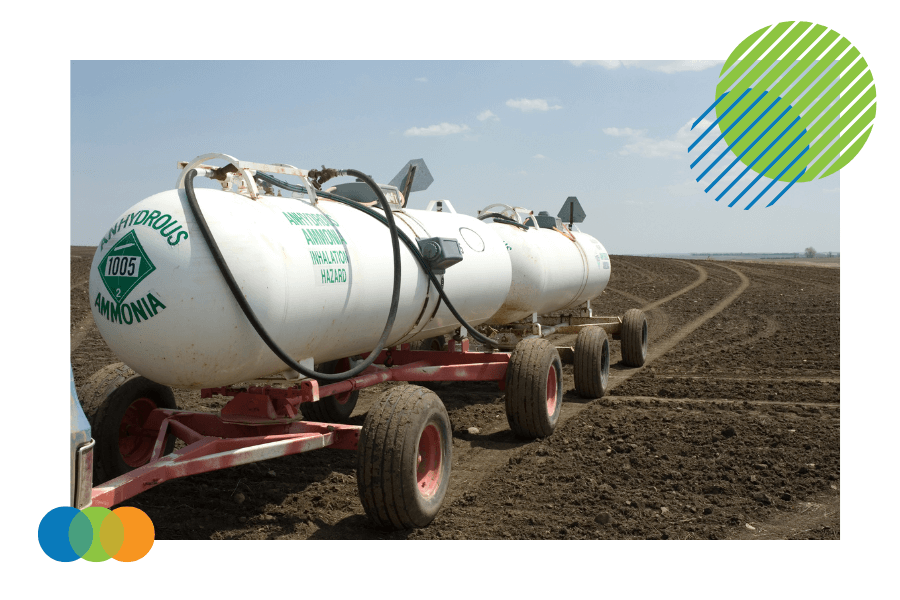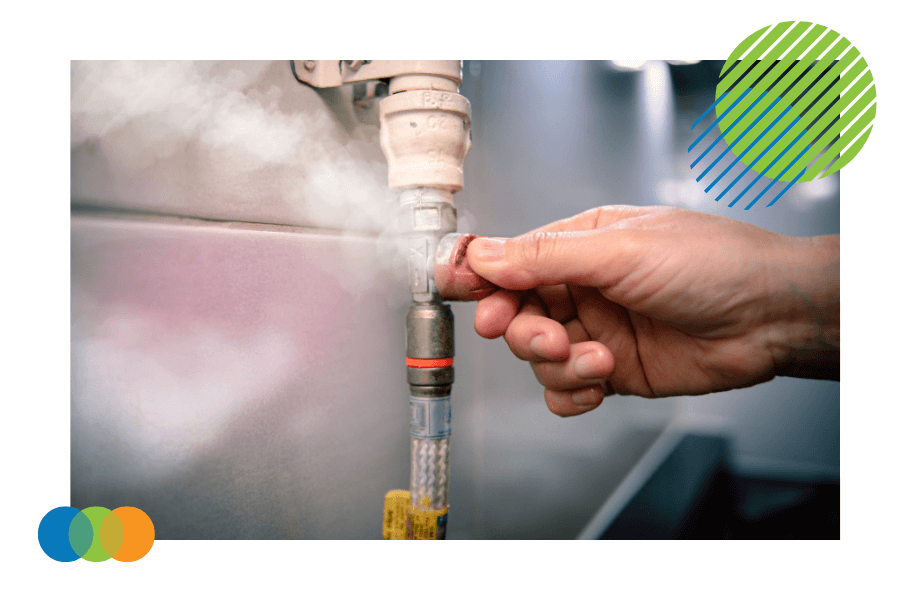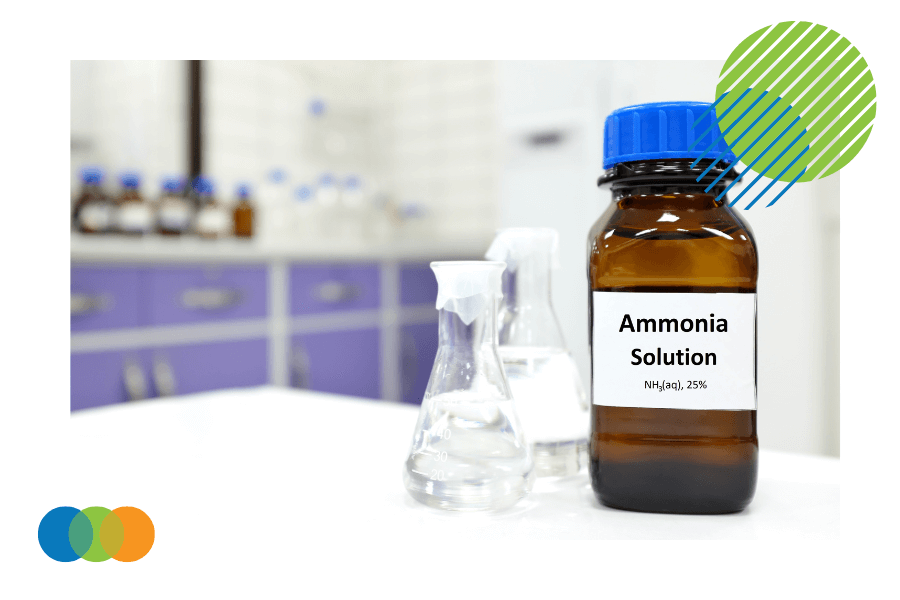 |
Written by Liz McDermott |

Ammonia is a commonly used chemical compound in various industries, including agriculture, refrigeration, and manufacturing. However, the truth about ammonia's flammability often lacks clarity. Knowing the different forms of ammonia, safety measures for handling and storage, and emergency response procedures are key to avoiding ammonia-related incidents.
This article helps us understand the facts about ammonia-related incidents and how proper safety protocols can ensure the safe handling of this chemical.

TABLE OF CONTENTS:
- What is Ammonia?
- Incidental Release Hazards of Ammonia and Respiratory Tract Risks
- What Are Unintentional Release Measures for Ammonia?
- Personal Protective Equipment When Working with Ammonia
- Labels, Marking, and Safety Signs Legal Requirements Associated with Ammonia
- Evaluation and Control When Working with Ammonia
- What Handling and Storage Practices Should Be Used When Working with Ammonia?
- What Are First Aid Measures for Ammonia?
- Is ammonia flammable? Understanding the Flammability of this Dangerous Chemical
- Common Misconceptions about Ammonia's Flammability
- What are Extinguishing Media for Ammonia?
- The Importance of Safe Handling and Storage of Ammonia
- Exploring Different Forms of Ammonia
- What is the American Conference of Governmental Industrial Hygienists (ACGIH®) Recommended Exposure Limit for Ammonia?
- Care and Maintenance of Anhydrous Ammonia Equipment
- Workplace Safety Measures When Working with Ammonia

What is Ammonia?
Ammonia (NH3) is a colorless gas with a pungent odor composed of nitrogen and hydrogen atoms and forms ammonium hydroxide when dissolved in water. Liquefied ammonia is when the gas is transformed into liquid ammonia by freezing it to a temperature of -28 degrees Fahrenheit or - 2 degrees Celsius. It is essential to understand the properties of ammonia to ensure its safe handling.
Ammonia is used not only in refrigeration systems and cleaning products but also as a raw material in producing fertilizers, plastics, heavy metals, and dyes. Therefore, it is crucial to be aware of its potential hazards to prevent accidents and ensure the safety of individuals working with or around this chemical.

Incidental Release Hazards of Ammonia and Respiratory Tract Risks
Accidental leaks or spills can occur during transportation, storage, or handling of ammonia, releasing a large amount of ammonia into the environment. These releases can pose significant risks to human health, safety, and the environment.
Ammonia releases can result in inhalation hazards, causing irritation and damage to the respiratory system, including pulmonary edema, a life-threatening accumulation of fluid in the lungs. It can also cause eye and skin irritation upon contact. Ingestion exposure can cause serious corrosive injury to the mouth, throat, esophagus, and stomach. Moreover, high ammonia concentrations in confined spaces can lead to asphyxiation tissue death due to oxygen displacement. Therefore, it is crucial to have adequate measures in place to prevent and respond to unintentional releases of this chemical.
What Are Unintentional Release Measures for Ammonia?
Implementing proper safety measures to minimize the risks associated with unintentional releases is essential. These measures include:
Risk assessment: Conduct a thorough risk assessment to identify potential sources of releases and develop appropriate control measures.
Preventive maintenance: Regularly inspect equipment, pipelines, and storage systems to detect and address potential leaks or failures.
Emergency response plan: Develop and implement an emergency response plan to effectively handle releases, including evacuation procedures, communication protocols, and containment strategies.
Training and awareness: Provide comprehensive ammonia safety training to workers on safe handling practices, emergency response procedures, and the proper use of PPE.
By implementing these measures, the risks associated with unintentional releases can be significantly reduced, ensuring the safety of workers and the surrounding environment.

Personal Protective Equipment When Working with Ammonia
When working with ammonia, wearing appropriate personal protective equipment (PPE) to minimize exposure to other chemicals and potential hazards is crucial. The following PPE should be used:
Respiratory protection: Since ammonia can cause respiratory irritation and damage, a respiratory protective device, such as a respirator, should be worn. The type of respirator chosen should be based on the concentration and duration of exposure.
Eye protection: Safety goggles or a full-face shield should be worn to protect the eyes from ammonia vapors or splashes.
Skin protection: Gloves made of chemically resistant materials, such as nitrile or neoprene, should be worn to prevent direct contact with ammonia. Additionally, chemical-resistant clothing and footwear should be worn to protect the skin from spills or splashes.
Other equipment: Depending on the specific task and potential exposure, additional PPE, such as aprons, face shields, or a chemical-resistant suit, may be required.
Ensuring that the chosen PPE is properly fitted, maintained, and used under safety guidelines is crucial. Regular inspection and replacement of PPE are essential to ensure its effectiveness in protecting against ammonia exposure.
Labels, Marking, and Safety Signs Legal Requirements Associated with Ammonia
Compliance with specific legal requirements associated with labeling, marking, and safety signs for ammonia-containing containers, pipelines, and storage areas is vital to promote safety and prevent accidents. These requirements ensure clear identification of the presence of ammonia and provide information about the potential hazards associated with its use.
Containers and pipelines containing ammonia should be labeled with the appropriate warning signs, symbols, and hazard statements. These labels should be easily visible and legible, indicating the nature of the tank truck and contents and the necessary precautions to be taken.
Also, storage areas with ammonia should have marked entry points and exit routes. Safety signs, such as "Danger - Ammonia" or "No Smoking," should be prominently displayed to alert workers to the potential risks and necessary safety precautions.
Evaluation and Control When Working with Ammonia
By conducting proper evaluations and implementing effective control measures, the risks associated with working with ammonia can be minimized, ensuring the safety and health of individuals in the workplace. Evaluations should include:
Exposure assessment: Assess the potential exposure levels of workers to ammonia through air monitoring and sampling.
Health surveillance: Implement regular health surveillance programs to monitor the health status of individuals working with or near ammonia.
Workplace monitoring: Monitor the workplace for potential leaks or releases of ammonia using appropriate detection equipment.
Control measures: Implement engineering controls, such as ventilation systems, to minimize ammonia concentration in the air. Administrative controls such as work rotation and restricted access should also be considered.
What Handling and Storage Practices Should Be Used When Working with Ammonia?
The risks associated with ammonia can be effectively managed by adhering to proper handling and storage practices, ensuring a safe working environment. Some recommended methods include:
Proper ventilation: Ammonia should be used in well-ventilated areas to reduce the concentration of vapors in the air. Adequate ventilation systems, such as exhaust fans or local exhaust ventilation, should be installed and regularly maintained.
Secure storage: Ammonia containers and cylinders should be stored in a cool, dry, and well-ventilated area away from incompatible substances. Storage areas should be appropriately labeled, and access should only be restricted to authorized personnel.
Avoidance of spills: Measures should be in place to prevent spills, leaks, or releases of ammonia. Proper handling techniques, including the use of appropriate equipment, should be followed to minimize the risk of accidents. Use water spray to reduce vapors or divert vapor cloud drift.
Proper transfer procedures: When transferring ammonia from one container to another, appropriate procedures should be followed to minimize the potential for leaks or spills. Suitable equipment, such as transfer pumps or hoses, should be used.
What Are First Aid Measures for Ammonia?
In prolonged eye exposure due to accidental contact, it is essential to administer appropriate first aid measures promptly. The following steps should be taken:
Inhalation: Move the affected individual to a well-ventilated area and provide fresh air. If breathing is difficult, provide artificial respiration or administer oxygen if available. Seek immediate medical attention.
Eye contact: Rinse the eyes thoroughly with water for at least 15 minutes while keeping the eyelids open. Contact an eye care professional for further evaluation.
Skin contact: Remove contaminated clothing and rinse the contaminated skin area with water for at least 15 minutes.

Is ammonia flammable? Understanding the Flammability of this Dangerous Chemical
Ammonia itself is not a flammable gas, but it can support combustion. This means that in the presence of a flame or spark, it can react with air and become explosive. However, for it to ignite, it requires a specific concentration in the air, known as the lower flammable limit (LFL). The LFL for this chemical is approximately 15% by volume. If the concentration falls below this threshold, there is not enough of it in the air to sustain combustion.
It is important to note that in gas form, it is lighter than air which tends to rise and disperse quickly. This property makes it less likely to reach its explosive concentration in normal conditions. However, concentrated amounts can build up in enclosed spaces or poorly ventilated areas, increasing the risk of flammability and severe injury.
Common Misconceptions about Ammonia's Flammability
There are several misconceptions surrounding the flammability of ammonia. One common myth is that it can explode in contact with water. While this chemical can react with water, this reaction does not result in an explosion. However, caution should be exercised when handling it and water, as the mixture can cause severe burns, irritations, and burns.
Another misconception is that ammonia is highly explosive. While it can support combustion, it has a relatively high ignition temperature compared to other flammable substances. This means that it requires a higher temperature to ignite.
What are Extinguishing Media for Ammonia?
In an ammonia-related fire, it is essential to understand the fire hazards and the appropriate extinguishing media. When it burns, it produces flammable hydrogen gas, intensifying the fire. Additionally, fires from this dangerous chemical can release toxic substances, posing risks to human health and the environment.
To extinguish this type of fire, it is recommended to use dry chemical or carbon dioxide extinguishers. These agents can effectively handle concentrated amounts and suppress the fire without causing further reactions. Water should never be used to extinguish a fire from this chemical, as it can react with it and create a hazardous situation.
The Importance of Safe Handling and Storage of Ammonia
Safe handling and storage of ammonia are crucial to prevent accidents and protect the health and safety of workers. When handling it, wearing appropriate personal protective equipment (PPE), including chemical-resistant suits, gloves, goggles, and respiratory protection, is essential. It can be an inhalation hazard, causing respiratory tract irritation and potential damage. Therefore, proper ventilation systems should be in place to minimize exposure.
It should be in cool containers and stored in well-ventilated areas, away from heat sources and incompatible substances. Containers leaking containers should be tightly sealed to prevent leaks, and proper labeling should be used to indicate the contents and potential hazards. Regular inspections and maintenance of equipment and storage facilities are also essential to identify and address potential issues.

Exploring Different Forms of Ammonia
Ammonia exists in different forms, each with its unique properties and applications. Anhydrous refers to it without water. Anhydrous ammonia is commonly used in refrigeration systems and as a fertilizer in the agricultural industry. Anhydrous ammonia is stored and transported as a liquid under pressure. The anhydrous ammonia market is projected to grow by 8% by 2030.
Ammonia Gas is the gaseous form of it and is often used in industrial processes. It is typically stored in pressurized cylinders. Mixing it with water to form ammonium hydroxide, an aqueous solution used in cleaning products, cosmetics, and refrigerants.
Each form of this chemical requires specific safety precautions during handling and storage.
What is the American Conference of Governmental Industrial Hygienists (ACGIH®) Recommended Exposure Limit for Ammonia?
The American Conference of Governmental Industrial Hygienists (ACGIH®) has established recommended exposure limits (RELs) for various chemicals, including ammonia. The REL is set at 25 parts per million (ppm) as a time-weighted average (TWA) for an 8-hour workday. This limit is based on protecting workers from respiratory and other health effects associated with exposure.
Employers should monitor the chemical levels in the workplace to ensure compliance with the ACGIH® REL. Proper ventilation systems, respiratory protection, and regular air quality testing are crucial to maintain a safe working environment.
Care and Maintenance of Anhydrous Ammonia Equipment
Anhydrous ammonia equipment, such as storage tanks and transfer systems, requires regular care and maintenance to ensure their integrity and prevent leaks or failures. Inspections should be conducted regularly to check for signs of corrosion, damage, or wear. Any identified issues should be taken care of quickly to prevent potential accidents or releases.
Proper ammonia safety training for workers involved in handling anhydrous equipment is essential. They should be knowledgeable about emergency shutdown procedures, leak detection, and proper response to equipment failures. Regular drills and exercises can help reinforce safety protocols and ensure a quick and effective response in an emergency.
Workplace Safety Measures When Working with Ammonia
Occupational safety should be a top priority when working with ammonia. Employers should provide comprehensive training programs to educate workers about the hazards of ammonia exposure, safe handling practices, and emergency response procedures. Workers should be equipped with the necessary personal protective equipment (PPE) and be trained in its proper usage and maintenance.
Regular risk assessments should be conducted to identify potential hazards and implement appropriate control measures. This may include implementing engineering controls, such as improved ventilation systems, or administrative controls, such as job rotation or work schedule modifications.
Emergency Response Procedures for Ammonia-Related Incidents
In an ammonia-related incident, prompt and effective emergency response is crucial to minimize the risks and protect lives and property. Emergency response procedures should be established and communicated to all personnel working with ammonia.
These procedures should include protocols for evacuation, notification of emergency services, and containment of ammonia leaks or spills. It is important to have designated personnel trained in emergency response to ensure a coordinated and efficient response. Regular drills and exercises can help familiarize workers with emergency procedures and ensure preparedness.
Safety Equipment and Protective Gear for Handling Ammonia
Proper safety equipment and other protective clothing and gear are essential for anyone handling ammonia. This includes chemical-resistant suits, gloves, goggles, and respiratory protection. When selecting PPE, it is vital to consider the specific form of chemical being handled and the associated hazards.
Respiratory protection is essential when working with this chemical, as inhalation of concentrated ammonia or vapor can be harmful. Respirators should be selected based on the level of exposure and should provide adequate protection against inhalation exposure to vapors. Regular fit testing and maintenance of respiratory equipment are essential to ensure their effectiveness.
Safe Disposal Methods for Ammonia
Proper disposal is necessary to prevent environmental contamination and protect human health. It should never be disposed of in sinks, toilets, or stormwater runoff into drains, as it can contaminate water sources and harm aquatic life.
Disposal methods for this chemical depend on the specific form and local regulations. It is recommended to consult with local authorities and direct water or waste management agencies to determine the appropriate disposal procedures. It should be collected and disposed of through authorized hazardous waste disposal services.
Conclusion: Ensuring Safe Handling of Ammonia
The flammability of ammonia can be a concern in certain conditions, but with proper understanding and precautions, the risks can be minimized. By following safe handling and storage practices, implementing appropriate safety measures, and being prepared for emergencies, we can ensure the safe use of this chemical in various industries.
Comprehensive ammonia safety training is vital to educate workers about exposure hazards and the necessary safety protocols. Online safety training programs can provide convenient and accessible resources for workers to enhance their knowledge and skills in handling it safely. Prioritize safety, protect lives, and safeguard the environment by taking the necessary steps.
Ensure the safety of your workforce by providing them with comprehensive online safety training. Visit our website to learn more about our specialized training programs for handling hazardous materials and chemicals like ammonia.
For more information, please contact us to inquire about our Health & Safety training programs.

